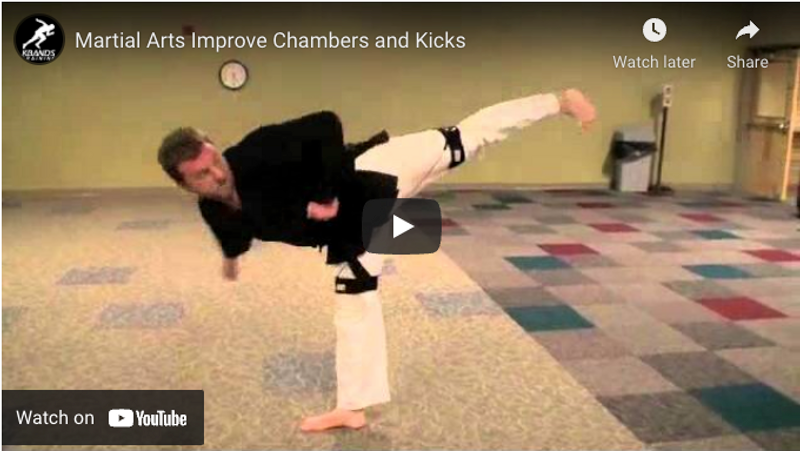Martial Arts Technique: Chamber Kicks
A long list of martial arts drawn from cultures all over the world rely heavily on the kick—a fast, un-telegraphed lower body move that requires high levels of core strength, flexibility, and balance. Martial arts kicks happen in countless ways and can apply force to almost any point on an opponent’s body from every direction, but chamber kicks (as they’re called in Taekwondo), are some of the most difficult to predict and counter, especially when they happen at high speed.
Martial Arts Kicks: What Is a Chamber Kick?
Chamber kicks are difficult to counter because the kicking leg lifts from the ground and gathers force before the opponent can accurately predict the movement or its direction. In this kind of kick, the knee is elevated before the kick is thrown, creating a space or angle (a chamber) between the upper leg and the ground before the athlete rotates the knee and commits to the kick. In this way, a chamber kick varies from a roundhouse kick, which is more common to martial arts like Muay Thai. While the roundhouse kick engages the entire leg from the hip down, the chamber kick involves a preparation at the hip followed by a quick snapping motion from the knee.
Both kicks can be effective in different situations, but while the roundhouse kick involves greater force (since the entire leg swings from the hip like a baseball bat), it also comes with greater momentum. This means that if the kicker misses the target, the body is still pulled through the motion, which can throw the kicker off balance and generate vulnerability to a counter attack. Chamber kicks aren’t as forceful, but they allow the body to stay under complete control before, during, and after the kick is delivered.
When executed correctly, chamber kicks are fast, controlled, and graceful. They’re a cornerstone of many beautiful martial arts sequences, and they can be devastating to an opponent. But excellent chamber kicks are difficult to deliver without a strong, flexible core, powerful hip flexors, and perfect balance.
Martial Arts Kicks: Why Lift and Straight Lines Matter
Elevation at the hip and a straight line between the upper leg and the ground are important to the force and execution of a strong chamber kick. All powerful kicks begin in the core, or the set of four muscle groups that surround the lower torso. These muscle groups include the abs (the rectus abdominus), the lower back (multifidis), the pelvic sling, and the diaphragm. If these muscles are strong, then the hip flexors that raise and lower the upper leg will have a powerful anchor point on which to build their own strength, and the hip flexors will in turn provide a powerful anchor point for the quads and other leg muscles that all lend force to the impact of a well delivered kick.
The stronger the core and hip flexors, the straighter the line will be in the lift of the upper leg. And the straighter this line, the more control an athlete will have over the motion and impact of the kick.
The Muscles Involved in Straight Kicks
Straight, perfectly controlled, perfectly directed chamber kicks can take place in any direction—to the front, to the side, or even directly behind the athlete. But in most cases, the lift and positioning of the chamber will place high demand on the muscles that lift the leg outward. The hip flexors, adductors, abductors that run down the side of the body and outer leg need routine exercise and constant tension to generate the necessary strength to deliver a good chamber kick.
To develop these muscles, athletes and martial artists usually spend countless hours practicing perfect kicks under the watchful eye of a trainer or coach. This is fine, since constant repetition can build the power necessary to lift the upper leg to a 45 or 90 degree angle and hold it there until the kick is complete. But the additional tension of the Kbands can demand greater effort from the legs and core and speed the development of these muscle groups.
How the Kbands Improve Lines and Increase Kicking Power
Before a martial arts practice session focused on chamber kicks, athletes can attach the straps of the Kbands around the upper leg just above the knee, with the label and metal rings facing outward. Then the Kbands resistance bands can be clipped to the metal rings with the longer band in front and the shorter band in back. Once the bands are in place, the regular repetition of kicks and standard training session can take place. But the added tension provided by the bands will increase the burn taking place in the muscles of the outer hip, the glutes, the hip flexors, or the quads, depending on the direction and style of the kicks.
To gain the maximum benefits of the Kbands and enhance the strength building benefits of a regular training session, athletes can repeat a regular cycle of kicks with the bands in place, followed by a second cycle with the bands removed. After a series of challenging kicks with the bands attached, most athletes will experience a temporary neurological sensation of extreme lightness for several minutes after the tension is removed. While this sensation is in effect, kicks will feel faster, lighter, and better controlled. And as training sessions continue, the leg and core muscles will gain strength, balance will improve, and chamber kicks will gain powerful speed and force.
Kbands and Chamber Kicks
This video offers a quick demonstration of the impact of Kbands resistance training equipment on the muscles responsible for strong chamber kicks. Athletes and martial arts trainers can consider building the Kbands into a regular session of kick-focused workouts that blend cardio, strength training, and technique. The added tension provided by the bands can help develop speed and strength and can bring fast results that will start showing up soon in the ring and on the practice floor.

